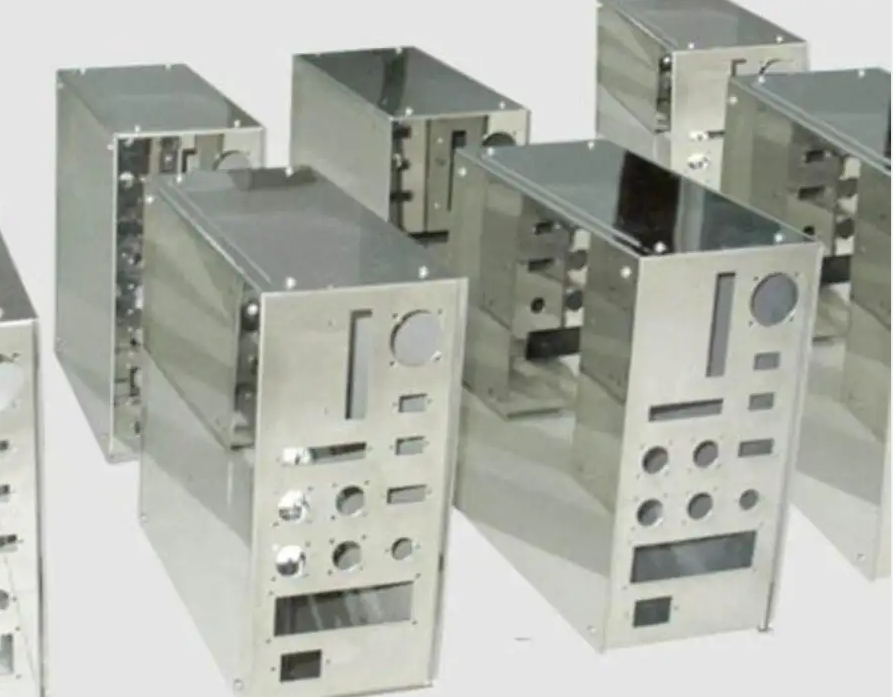Sheet metal is a comprehensive cold working process of sheet metal (usually less than 6mm), including shearing, punching/cutting/compounding, folding, welding, riveting, splicing, forming (such as car body), etc. Its distinguishing feature is that the same part has the same thickness. This is called sheet metal processing. The sheet metal parts referred to by different industries are generally different and are mainly used for assembly.
Sheet metal parts have the characteristics of light weight, high strength, electrical conductivity (can be used for electromagnetic shielding), low cost, and good mass production performance. Widely used in electronic appliances, communications, automotive industry, medical equipment, and other fields. For example, sheet metal parts are essential parts in computer cases, mobile phones, and MP3s. With the increasing application of sheet metal parts, the design of sheet metal parts has become a very important part of the product development process. Mechanical engineers must master the design skills of sheet metal parts so that the designed sheet metal can not only meet the requirements of product function and appearance but also make the manufacture of stamping dies simple and low cost.
Sheet metal processing steps
Generally speaking, the three important steps in sheet metal factory are cutting, punching/cutting, and folding sheet metal sometimes called sheet metal. The word comes from sheet metal in English. Generally, some sheet metal is plastically deformed by hand or die pressing to form the desired shape and size, while more complex parts can be formed by welding or a small amount of machining, such as chimneys, tin pots, and commonly used in households car shell. Sheet metal processing is called sheet metal processing. Specifically, for example, chimneys, iron drums, oil tanks, oil cans, ventilation pipes, large and small ends of elbows, circular positions, funnel shapes, etc. are made using sheet materials. The main processes are shearing, bending, edge buckle, bending forming, welding, riveting, etc., which require certain geometric knowledge.
Sheet metal parts are the parts that can be processed by stamping, bending, stretching, and other means. The general definition is – a part with constant thickness during machining. The corresponding parts are cast parts, forged parts, machined parts, etc. For example, the iron shell outside the car is a sheet metal part, and some stainless steel kitchen utensils are also sheet metal parts.
Common problems and causes of sheet metal processing and stamping processing
1 Burr: The excess material is not completely left in the process of stamping or chamfering, and burrs appear under the section of the steel plate. When the burr height is greater than 0.2mm according to the cross-section, the iron powder will damage the mold and cause convex and concave.
2. Concave and convex: The surface of the material is unusually convex and concave, which is due to the uncoiled wire.
3 caused by the mixing of foreign objects (iron filings and dust). Roll marks: Caused by foreign matter adhering to the cleaning roller or feed roller (fixed pitch). Generally speaking, foreign objects rolled on the paper can be removed.
4. Slip marks: due to rollers.
5. Slip marks appear when the roller suddenly stops or accelerates. Crushing of the rolls can cause wrinkling at the edges: The guide rolls on the uncoiler line can cause wrinkling due to the small gap between the guide rolls on the die, due to the rolls.
6 is caused by unbalanced feeding. Scratches: The main cause of parts being scratched is sharp scars on the mold or metal dust falling into the mold. Precautions are the sanding of scars on the mold and the removal of metal dust.
7. Bottom cracking: The main reason for the bottom cracking of parts is poor material plasticity or too tight a die holder. The preventive measure is to replace the material with good plasticity or loosen the blank holder.
8. Sidewall wrinkling: The main reason for the wrinkling of the sidewall of the part is the insufficient thickness of the material (if it is relatively small, the thickness is allowed to be thinner) or the eccentricity during the installation of the upper and lower molds, resulting in a large gap on one side and a small gap on the other side. Precautions are to replace the material immediately and readjust the mold.
Related searches: sheet metal steel, sheet metal aluminum

